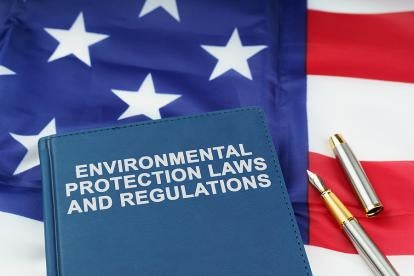On March 20, 2024, the Environmental Protection Agency (EPA) finalized greenhouse gas (GHG) and other pollutant standards for light- and medium-duty passenger vehicles. By setting stringent fleetwide emissions targets for model years (MY) 2027 to 2032, the new standards significantly reduce emissions of greenhouse gases (GHG), hydrocarbons, nitrogen oxides (NOx), and fine particulate matter (PM2.5) from new passenger cars, light trucks, and larger pickups and vans. These new standards should continue to spur product electrification.
As compared to the proposed rule, EPA slowed the timeline for automakers to comply with the standards, with the overall emissions reductions in the final year being the same. Specifically, the GHG standards ramp up more slowly in MYs 2027-2030 as compared to the proposal. EPA does not technically require the electrification of vehicle fleets in the final rule, but manufacturers are expected to comply with the stronger emission standards by selling more electrified vehicles.
EPA estimates that under the rule, 68 percent of new passenger vehicles sold in 2032 will be electric. Currently, EV sales only make up roughly 9 percent of new passenger vehicle sales. Regarding fleet turnover, EPA projects that 84 percent of vehicles on the road will be gasoline or diesel in 2032, and 58 percent will be gasoline or diesel in 2055.
The final rule aims to avoid 7.2 billion tons of GHGs through 2055. It is expected that there will be a 50 percent reduction in GHGs from light-duty vehicles in MY2032 and a 44 percent reduction from medium-duty vehicles as compared to MY2026.
The rule not only implements tougher GHG standards for passenger vehicles but also strengthens limits on conventional air pollutants—a step that likely will lead to further electrification of this segment of the transportation sector. In addition to the GHG reductions through 2055, the rule also is expected to reduce PM2.5 emissions by 95 percent, and emissions of NOX and other ozone precursors by 75 percent.
The final rule codifies a fleetwide average light- and medium-duty vehicle GHG standard at 85 grams-per-mile (CO2 g/mi), and a PM2.5 standard at 0.5 milligrams per mile (mg/mi). Regarding non-methane organic gases and NOx (NMOG+NOx), for light-duty vehicles, the standard phases down to a fleet average of 15 mg/mi by 2032, which is a 50 percent reduction from the existing standard established in 2014 under EPA’s Tier 3 program. For medium-duty vehicles, the NMOG+NOx standard is 75 mg/mi by 2033, a 58-70 percent reduction from Tier 3 standards.
The final rule also dropped a proposal to prohibit “commanded enrichment” for gasoline and hybrid vehicles. As proposed, the regulatory requirement would have required the re-engineering of certain engines in many light trucks, SUVs, and performance vehicles. The rule also extends the phase-in period for Small Volume Manufacturers to comply with the applicable emission standards.
The final rulemaking notes the ability of automakers to comply with the new requirements via a diversity of fuel-saving technologies. There are multiple compliance strategies for automakers, including the ability to comply with plug-in hybrid electric vehicles (PHEVs) and an extension of “off-cycle” credits through MY2032. Another change from the proposal is the use of greater credits for refrigerants with a reduced global warming impact. These flexibilities may bolster potential arguments by EPA in defending a legal challenge that the final rule mandates EVs.
Through 2055, EPA estimates the final rule will have net annual benefits of $99 billion under a 2 percent discount rate. These include climate benefits of $72 billion; public health benefits of $13 billion; reduced maintenance costs of $14 billion; and $46 billion in fuel savings. This amounts to approximately $6,000 per vehicle in savings. Compliance costs for manufacturers will increase by approximately $1,200 per light-duty vehicle sold, and the regulation will increase annual vehicle costs by $40 billion and insurance premiums by $1.5 billion.
Heavy-Duty Truck Standards
The White House Office of Management and Budget (OMB) also finished interagency review of EPA’s draft final “Phase 3” GHG standards for heavy-duty trucks, clearing the path for the final rule to be released soon. Like the passenger vehicle rule, the Phase 3 heavy truck standards would begin in MY 2027. It is unknown whether the Phase 3 rule will include similar easing of the phase-in requirements for certain truck classes, especially heavier Class 8 long haul and Class 7 long and short haul vehicles. OMB completed review of the standards on March 15, 2024, just one day after OMB finished review of the separate passenger vehicle standards. Public release of the heavy-duty rule is expected imminently.
DOE Finalizes Petroleum Equivalency for Batteries
Along with the new EPA passenger vehicle standards, the Department of Energy (DOE) finalized the “petroleum equivalency factor” (PEF) calculation, which is a formula used to determine how EVs are scored under the Department of Transportation’s corporate average fuel economy (CAFE) standards, which are separate and apart from EPA’s final tailpipe standards discussed above. DOE finalized the new PEF on Tuesday, March 19, 2024. The metric was last updated in 2000, though it is required to be reviewed annually. The final rule cuts the PEF standard by 65 percent and phases in the reduction from MY2027 to 2030. With a lower PEF, EVs will not provide manufacturers’ fleets with the same degree of fuel economy improvement as in the past.
Interplay with California Standards
Manufacturers will have to navigate compliance with the new EPA rule along with California’s Advanced Clean Cars (ACC) Program. The ACC regulations scale down emissions of light- and medium-duty vehicles and require an increased number of zero-emission vehicles (ZEVs) to meet air quality and climate change emissions goals. ACC II regulations were adopted by the California Air Resources Board (CARB) in 2022, implementing low- and zero-emission vehicle standards for MYs 2026-2035 that contribute to meeting federal national ambient air quality standards (NAAQS) for ozone and California’s carbon neutrality targets. By 2035, CARB’s goal is that all new passenger cars, trucks, and SUVs sold in California will be zero emissions vehicles.
The federal Clean Air Act (CAA) allows California to seek a waiver of preemption prohibiting states from enacting emission standards for new motor vehicles. EPA must grant a waiver before California’s rules may be enforced. In late December 2023, EPA requested public comment on granting a preemption waiver for the ACC II regulations. A public hearing was held in January 2024, and comments were due by February 27, 2024.
The CAA allows other states to adopt California’s motor vehicle emission standards under section 177 so long as they are identical. Regarding the adoption of the first ACC regulations (ACC I) that cover through MY2025, seventeen states in addition to California adopted CARB’s ZEV standards; the same states plus Pennsylvania adopted CARB’s low-emission vehicle (LEV) standards.[1] Together, these states represent more than 40% of the U.S. car market.
Next Steps
These federal rulemakings—(1) EPA’s passenger vehicle GHG and criteria pollutant standards; (2) EPA’s heavy-duty vehicle Phase 3 standards; (3) DOE’s PEF calculation; and (4) DOT’s CAFE standards—are intended by the Biden Administration to work in tandem to reduce GHG and other pollutants from the U.S. transportation system.
The change in phase-in schedules between EPA’s proposed rule and final GHG and multipollutant regulation allows more time for manufacturers and suppliers to continue research and development and scale up for the necessary technology implementation. It also allows for additional time to expand and improve charging networks.
Still, there will likely be legal challenges mounted against several of these rules given the myriad of interests at play in this sector. Particularly for the GHG and multipollutant standards, opponents are likely to argue that the rule is an EV mandate and claim EPA has asserted highly consequential power beyond what Congress could reasonably be understood to have granted in violation of the Major Questions Doctrine (MQD). The MQD is a more rigorous legal standard of review than the former leading standard, Chevron deference, under which agencies received significant leeway to regulate so long as they had a reasonable interpretation of the statute.
The final rule will take effect 60 days after publication in the Federal Register. This final rule starts not only an engineering and product planning process for vehicle manufacturers but also a complex set of legal, political, and policy issues that will shape the vehicle industry for years to come.
[1] States adopting California’s standards for zero-emission vehicles (ZEVs) include California, Colorado, Connecticut, Delaware, District of Columbia, Maine, Maryland, Massachusetts, Minnesota, Nevada, New Jersey, New Mexico, New York, Oregon, Rhode Island, Vermont, Virginia, and Washington. The same states plus Pennsylvania adopted California’s low-emission vehicle (LEV) standards. Arizona and Florida previously repealed the LEV standards.






 i
i


